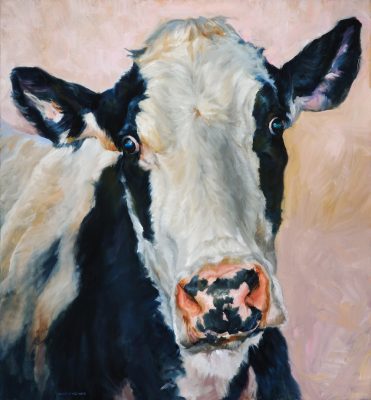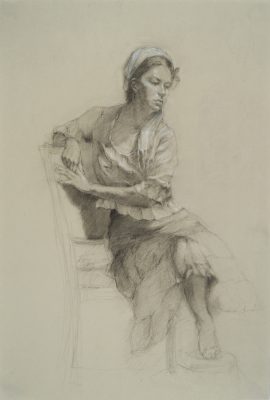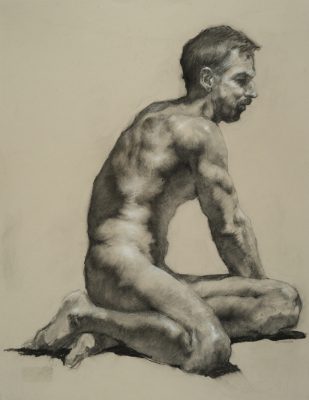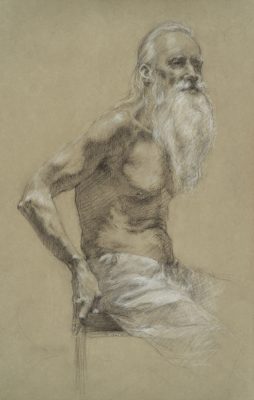Give up dairy? Not Diane Weiner.

The Bethesda-based artist—retired from teaching and fully focused on drawing and painting in a variety of media from metal point and trois crayon to charcoal and oils—has an exhibit at Strathmore that lovingly details the beauty of bodies and space, telling stories through muscle, sinew, expression and stance. Half of those bodies are human; they repose, recline, gaze away in mysterious reveries. Half of those bodies are cows.
“I have been painting cows for over 15 years,” said Weiner, who grew up in Brooklyn, the daughter of a kosher butcher. She laughed—she laughs a lot—because she knows it may seem a bit unusual. “When I get an idea, I really love to explore it,” she explained. “I do other things, but I love cows and people. They’re two passions that just have run on for decades.”
For Weiner, cows and people have similar qualities: both are emotive, expressive and unique. Both use body language to communicate, although cows tend to use it exclusively. Still, the artist (a graduate of the State University of New York at New Paltz who has studied the great masters and worked with cadavers to learn the ins and outs of anatomy) understands.

“They speak to me,” she said. “Their personalities and their portraits. Honestly, I don’t know where they came from, but I see them as people.”
People, cows—whatever Weiner paints or draws, she has a way of finding its essence that didn’t go unnoticed by Gabrielle Tillenburg, who worked with Weiner to get this solo show into the Invitational Gallery at the Mansion at Strathmore.
“She’s a very personable artist,” said Tillenburg, Strathmore’s visual arts coordinator. “I visited her studio and was most impressed with the way she had the ability to capture a moment. She captures people in this momentary pose, so that you almost feel a certain level of privilege to be engaging with them.”
With cows, exotic to most people in our modern urban world, the engagement feels like something more than a privilege. “There’s something very special and fleeting about this moment of looking a very large creature that’s not human in the eye,” Tillenburg observed.
Like “Buttercup,” the haughty heifer Weiner represents bathed in a flattering tawny light. “Buttercup is very sassy,” said Weiner. “I see her as having false eyelashes; she would be the one who’d spend hours with makeup and accessories.” Other cows exude similarly anthropomorphic expressions, inviting viewers to get to know them even as the human figures hung between them serve as studies in mysterious humanity. A storyteller in a sailor’s clothes, a dancer engrossed in a detail of her costume, a regal young woman under an exotic headdress—it’s the contour that creates the beauty, whether the subject is bovine or not.

One difference: while her cows are wrought in oil, Weiner uses Renaissance techniques for her humans. “I work on handmade paper, twinrocker paper,” she explained. “I tint it and then I shellac it so that it’s really tough. And then I use two pencils, the red and the black, and sometimes a heavy eraser to get warm and cool tones.” It’s evocative of (Flemish painter Peter Paul) Rubens, she noted, “more like an adaptation of an old technique, making it modern.
“Everything has kind of a rhythm; everything is not finished to the same level—because that would feel boring; your eye has no place to rest.”
Weiner said she’s concerned with anatomy and transitions; she is comfortable with dichotomy in life and in work. “I have no trouble with things that are supposedly not rational, with opposites,” she said. “I have no problem loving cows and connecting with them and having filet mignon. It’s just the way I am.”
She also has no problem with her role elevating a subject traditionally considered kitschy to high art. “When I tell people I paint cows, they have different preconceptions about what my work is like,” Weiner admitted. “But the people who collect my cows tend to be people who are sophisticated visually. When I see my paintings in (buyers’) homes, they’re in living areas where people have super-fine antiques and much more traditional paintings.”
For her human portraits, Weiner sketches posed human models in the comfortable confines of a studio, but getting to her bovine models requires a bit of legwork. She says she’d love “a grant where I could travel around the world and paint the cows,” but for now she’s relatively local, sketching longhorns on a farm near Camp David. Up in Frederick, she said, she found a farm where the animals had “names, not numbers,” and a kindly farmer with calloused hands who let her come on to his property to sketch the herd.

“He thought it was crazy,” she said. “He just kind of laughed, at first, but he got used to me.”
She’s no farmer herself—there’s still quite a bit of Brooklyn in her mien—but what Weiner lacks in basic barnyard savvy she makes up for in artistic knowledge and in sheer love for her bovine subjects.
“I feel like I know everything I need to know about cows,” she said. “I know their faces, I know their bodies, I know their skin feels, how their fur feels, their bones. I know the texture of the nose, the mouth; I know what’s cold, what’s wet. I know the things that are important to me.”
And she knows that the days of cows in tranquil pastures are numbered. Weiner has a collection of anecdotes to go along with her paintings, and these stories about meeting animals and people in beautiful settings seem like increasingly rare opportunities.
“I really feel privileged,” she said. “All these farms that I’ve been going to are disappearing, and people like that farmer are an anomaly. I almost feel like I’m stepping back in time, and I have the privilege of being introduced to this world that’s rapidly going away.
“I like being lost in there,” she added. “It’s kind of special.”
“Bodies of Work” by Diane R. Weiner is in the Invitational Gallery at The Mansion at Strathmore, 10701 Rockville Pike, North Bethesda, through Jan. 7. Hours are 10 a.m. to 4 p.m. Tuesday, Thursday, Friday and Saturday; 10 a.m. to 9 p.m. Wednesday, and noon to 4 p.m. Sunday. Admission is free. Call 301-581-5100 or visit www.strathmore.org/visual-arts/exhibitions. Learn more about this exhibition on CultureSpotMC here.